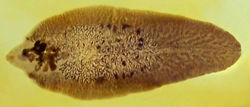Anthelmintic Drugs
| This article has been peer reviewed but is awaiting expert review. If you would like to help with this, please see more information about expert reviewing. |
|
|
These chemotherapeutic agents are selectively toxic pharmaceutical compounds that aid in parasite control without damage to the host. They are selectively toxic as they have greater affinity to the parasite target site than a similar site in the host. The drugs here are all used for activity against the different classes of helminths but some also have activity against ectoparasites and are known as endectocides.
These drugs as usually formulated so that they can be administered orally (in drench, tablet or in feed form), by injection or percutaneously (as a pour on). In cattle production intraruminal delivary systems or rumen boluses have been developed. They are capable of delivering the anthelmintic for periods of over 90 days. There are two types of delivery system. The sustained release boluses work via a diffusion gradient, osmotic pump or mechanical device and emit the anthelmintic at a constant rate. The pulse release boluses emit therapeutic doses every three weeks. Oxfenbendazole is currently the only drug that has been formulated in this way.
On the following pages we shall discuss all the main classes of anthelmintics that are on the market, how they work and which classes of parasites they are active against. Some of the products are labelled with a coding system in the UK. This is in attempt to make it easier for farmers and vets to choose which group of drug would be best to use. This is because each group has a similar mode of action and so hopefully the coding system will help avoid resistance problems.
- Levamisole
- Morantel
- Macrocyclic Lactones - Avermectins and Milbemycins
- Cyclo-octodepsipeptides - CODPs
- Benzimidazoles
- Salicylanilide Flukicides
- Praziquantel
- Arsenicals - Thiacetarsamide has been used to treat the adult heartworm but is very toxic. It is hepatotoxic, nephrotoxic and will cause necrosis if not injected directly into the vein. Melarsomine is a new drug that has just become available.
Literature Search
Use these links to find recent scientific publications via CAB Abstracts (log in required unless accessing from a subscribing organisation).
Beyond anthelmintics: parasite management in small ruminants. Snyder, J. H.; The North American Veterinary Conference, Gainesville, USA, Large animal. Proceedings of the North American Veterinary Conference, Volume 21, Orlando, Florida, USA, 2007, 2007, pp 273-279 - Full Text Article

